Heitjans P., Karger J. (Eds.). Diffusion in Condensed Matter: Methods, Materials, Models
Подождите немного. Документ загружается.


700 Gerhard N¨agele, Jan K. G. Dhont, and Gerhard Meier
of interactions between the monomers and the incompressibility constraint,
but with the chain connectivity maintained. As a mean-field-type theory, the
(dynamic) RPA should apply only to dense systems (i.e. melts) of sufficiently
long polymer chains where density fluctuations are small. Furthermore, its
predictions are most reliable for small values of q (as the ones probed in the
diffusive limit) since, as the name RPA implies, it involves an averaging over
the directions (phase) of q.
The mobilities {µ
l
αβ
}, with α, β ∈{A, B}, of an incompressible ternary
mixture are expressed in the dynamic RPA in terms of the mobilities, µ
0
αβ
,
of the bare system as [109]
1
µ
l
αα
=
1
µ
0
αα
+
1
µ
0
ββ
+
1
µ
0
ββ
+ µ
0
CC
(16.255)
1
µ
l
αβ
= −
1
µ
0
αα
+
1
µ
0
ββ
+
µ
0
CC
µ
0
αα
µ
0
ββ
,α= β
where µ
0
CC
is the mobility of a C-matrix monomer in the bare system. The
mobilities µ
0
αβ
are related to the self-diffusion coefficients in the bare system
by
µ
0
αβ
= δ
αβ
N
α
D
0α
k
B
T
, (16.256)
with D
0α
= k
B
T/γ
α
the self-diffusion coefficient of an α-type monomer re-
lated to the monomer friction coefficient γ
α
. This result for µ
0
αβ
is obtained
from adopting for the bare system the Rouse model for the dynamics of non-
interacting and non-self-avoiding Gaussian chains [13,106] (cf. also Sect. 13.4
of Chap. 13). Here, we use that in a dense system of chains like in a melt,
each chain is to a good approximation Gaussian and ideal, with R
G
∝ N
1/2
.
Within the Rouse model of non-interacting chains,
S
0
αβ
(q, t)=δ
αβ
N
α
p
α
exp{−q
2
D
p
0α
t} (16.257)
for qR
G
1andfortimest large compared to the relaxation times of the
internal modes of a Rouse chain. Here, D
p
0α
is the center-of-mass self-diffusion
coefficient of a polymer chain, related to the monomer diffusion coefficient by
D
p
0α
= D
0α
/p
α
,andp
α
is the degree of polymerization of an α-chain. Note
that S
0
αα
(q, t)/N
α
is the dynamic structure factor of a single Rouse chain. The
monomer friction coefficient, γ
α
, enters the Rouse dynamics as a parameter
that must be specified as an input from elsewhere. Hence, γ
α
and D
0α
are
usually interpreted as the friction coefficient and self-diffusion coefficient of an
α-monomer in the actual mixture of interacting chains. As such they depend
implicitly on the composition and temperature of the mixture. Moreover, it is
then necessary to distinguish between systems of unentangled chains, where
D
p
α
= D
α
/p
α
, and systems of very long chains governed by the reptation
process, where D
p
α
= D
α
/p
2
α
[29,106].

16 Diffusion in Colloidal and Polymeric Systems 701
For an application of the RPA, consider first an incompressible binary
blend, without any additional matrix molecules or vacancies. Substitution
of (16.255) and (16.256), with µ
0
CC
set equal to zero, into (16.254) leads for
unentangled chains to
(Nx
A
x
B
)Λ
l
in
=
x
B
p
A
D
p
0A
+
x
A
p
B
D
p
0B
−1
, (16.258)
which is the slow-mode form for the long-time kinetic coefficient (cf. (16.145)).
Recall here that the definitions of Λ
l
in
and S
in
in (16.130) and (16.117), respec-
tively, differ from the ones used in this subsection by a factor of N (x
A
x
B
)
2
.
This factor renders them into intensive,i.e.N-independent, quantities. Ac-
cording to (16.258), the RPA predicts thus that the interdiffusion process in
a binary incompressible blend is dominated, for D
p
0A
D
p
0B
,bytheslow
component A, which enslaves the dynamics of the fast component B in the
absence of voids.
To obtain D
l
in
, we need to divide Λ
l
in
by S
in
(q = 0). The latter is ob-
tained, for consistency, from the static limit of the RPA. For an incompress-
ible ternary blend of A and B chains in a matrix of C chains, the static RPA
relates the 2 ×2 static structure factor matrix, S(q, t), of A and B monomers
in the interacting system to the static structure factor matrix, S
0
(q, t), of the
bare system via (for details see [28, 106, 109])
S(q)
−1
=
S
0
(q)
−1
+ v(q) . (16.259)
Here, v(q)isa2×2 excluded volume matrix of elements v
αβ
(q), with α, β ∈
{A, B}, which accounts for the interactions between monomers of type α and
β, and for the incompressibility constraint.
The partial static structure factors of the bare system of non-interacting
Gaussian chains are explicitly
S
0
αβ
(q)=δ
αβ
p
α
f
D
([qR
Gα
]
2
) , (16.260)
where f
D
(x) is the Debye function [106], with f
D
(x) ≈ 1 −x/3forx 1, and
R
Gα
is the radius of gyration of an α-type chain. Using (16.260) specialized to
qR
Gα
1, the RPA result in (16.259) simplifies for a binary incompressible
melt to
1
S
αα
=
1
N
a
+
1
N
B
2
1
S
in
=
1
N
1
x
A
p
A
+
1
x
B
p
B
− 2Nχ
AB
. (16.261)
The Flory-Huggins interaction parameter, χ
AB
, is related to the spatial
Fourier transforms, w
αβ
(q), of the local interaction potentials, w
αβ
(r), of
α and β monomers by [28, 106]
χ
AB
= lim
q→0
1
k
B
TV
w
AB
(q) −
1
2
(w
AA
(q)+w
BB
(q))
, (16.262)

702 Gerhard N¨agele, Jan K. G. Dhont, and Gerhard Meier
so that χ ≡ Nχ
AB
can be interpreted as the Flory-Huggins interaction pa-
rameter per segmental volume v
s
= V/N,forequalsegmentalvolumesof
both polymer components. Typically, χ exhibits an inverse temperature de-
pendence. Finally, (16.258) and (16.261) yield
D
l
in
=
1
x
A
p
A
+
1
x
B
p
B
− 2χ
1
x
A
p
A
D
p
0A
+
1
x
B
p
B
D
p
0B
−1
. (16.263)
Experiments on binary blends (see the discussion given below) have re-
vealed that the slow-mode result does not satisfactorily describe, in general,
the dependence of Λ
l
in
on the molecular weight (say p
A
) of its constituents.
The observed discrepancy between the slow-mode result for binary incom-
pressible melts and experiment may be due to the presence of vacancies,
which add some amount of compressibility to the mixture. When instead of
a binary melt, a ternary incompressible blend of A and B chains in a matrix
of C-chains is considered, Λ
l
in
can be derived within the dynamic RPA from
substituting (16.255) and (16.256) into (16.251). This leads to the so-called
ANK expression,
(Nx
A
x
B
)Λ
l
in
=
x
B
p
A
D
p
0A
+ x
A
p
B
D
p
0B
−
x
A
x
B
(p
A
D
p
0A
− p
B
D
p
0B
)
2
x
A
p
A
D
p
0A
+ x
B
p
B
D
p
0B
+ x
C
p
C
D
p
0C
,
(16.264)
for the kinetic coefficient of unentangled chains, originally derived by Akcasu,
N¨agele and Klein [28]. Quite remarkably, this expression reduces to the fast-
mode form (cf. (16.141)),
(Nx
A
x
B
)Λ
l
in
=[x
B
p
A
D
p
0A
+ x
A
p
B
D
p
0B
] , (16.265)
in the limit of a large self-diffusivity and/or large concentration of matrix
molecules, that is for x
C
p
C
D
p
0C
x
α
p
α
D
p
0α
. In this ’solution-like’ limit,
g
E
(q, t) decays in a superposition of two normal modes where, contrary to
the incompressible case, d
−
and, likewise, d
+
cannot be identified with the
interdiffusion process [28]. The slow-mode result is recaptured from the ANK
formula when the matrix is removed, i.e. for x
C
p
C
D
p
0C
→ 0, resulting again
in an incompressible mixture of A and B chains. If one is allowed to stretch
the validity of the RPA result in (16.264) by allowing the matrix to consist
of vacancies instead of homopolymers, the ANK formula predicts a gradual
transition from the fast-mode form to the slow-mode form of Λ
l
in
,whenthe
vacancy concentration, or compressibility, of the mixture is reduced.
Having analyzed the implications of the dynamic RPA and the Flory-
Huggins model for the long-time interdiffusion in binary melts, we proceed
to scrutinize the RPA predictions against DLS and time-resolved static light
scattering experiments on binary homopolymer blends. In DLS experiments
on binary blends, an apparent diffusion coefficient,
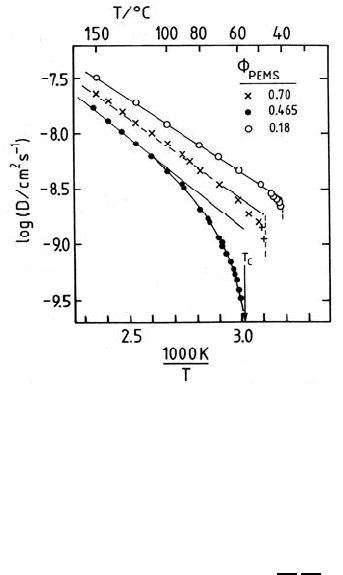
16 Diffusion in Colloidal and Polymeric Systems 703
Fig. 16.29. Arrhenius plot of the apparent D for a binary blend of PDMS (p = 260)
and PEMS (p = 340) chains for three different compositions of φ
PEMS
as indicated,
including the critical one at φ
PEMS
=0.465. The critical temperature T
c
=57
◦
C,
is indicated by an arrow. The two non-critical data sets for D terminate at the
binodal phase-coexistence points. Data from [110].
D ≡−
1
q
2
∂
∂t
ln g
E
(q, t)|
t=0
, (16.266)
is determined, in the diffusive limit, from a cumulant analysis. Within the
RPA, D is identified with D
l
in
= Λ
l
in
/S
in
in case of incompressility, with Λ
l
in
given by the slow-mode expression in (16.258). Fig. 16.29 shows DLS results
for D in the homogeneous one-phase region, for an almost symmetric mixture
of poly(ethylmethylsiloxane) (PEMS) chains of polymerization index p = 260
and poly(dimethylsiloxane) (PDMS) chains (with p = 340), with both indices
below the entanglement threshold. In this so-called Arrhenius plot, the loga-
rithm of D is plotted versus the inverse system temperature for three different
volume fractions φ
PEMS
= x
PEMS
of PEMS, including the critical composi-
tion φ
PEMS
=0.465. This figure nicely illustrates, for φ
PEMS
=0.465, the
phenomenon of critical slowing down, when T is lowered in the one-phase
region to approach the temperature, T
c
, at the critical point of demixing (cf.
also Chap. 15, Fig. 15.14). Near the critical point, certain composition fluc-
tuations become anomalously large, and diffusion becomes increasingly slow,
with D going to zero for T → T
c
. Demixing through spinodal decomposition
sets in when the temperature is lowered below T
c
. The critical point is the
location of a second-order phase transition, characterized by universal scaling
laws of its critical exponents (see [110] for details).

704 Gerhard N¨agele, Jan K. G. Dhont, and Gerhard Meier
In the one-phase region T>T
c
,withT not too close to T
c
, the behavior
of S
in
and D
l
in
can be described by the mean-field RPA, where the very small
values of D = D
in
near the critical point are ascribed to the divergence of
S
in
= S
in
(q = 0) at the spinodal line. The (mean-field) spinodal line separates
the phase region of mechanical stability from the unstable one. The values of
the interaction parameter χ at the spinodal follow from (16.261) as
2χ
s
(φ)=
1
φp
A
+
1
(1 − φ)p
B
, (16.267)
with φ = x
A
and (1−φ)=x
B
. This allows us to reformulate the (slow-mode)
RPA result in (16.263) as
D
l
in
= φ(1 − φ) · 2[χ
s
(φ) − χ] · W
0
, (16.268)
with W
0
defined by
W
0
=
(1 − φ)
p
A
D
p
0A
+
φ
p
B
D
p
0B
−1
. (16.269)
We have factorized D
l
in
here in a geometric factor, φ(1−φ), a thermodynamic
factor, 2(χ
s
− χ), and in a kinetic factor, W
0
. The kinetic factor depends in
the unentangled case on the monomer diffusivities D
0α
= p
α
D
p
0α
and φ only.
For the following discussion, it is convenient to absorb a factor N [φ(1−φ)]
2
into the definitions of S
in
and Λ
l
in
, which renders them intensive. Using this
re-definition, S
in
is given by
S
in
=
1
2(χ
s
− χ)
=
1
φp
A
+
1
(1 − φ)p
B
− 2χ(T )
−1
, (16.270)
with zero values of S
in
at the end-points Φ =0, 1 of pure components, and a
parabolic shape of S
in
in between. For the kinetic factor then follows
W
0
=
D
l
in
S
in
φ(1 − φ)
= Λ
l
in
φ(1 − φ) . (16.271)
While (16.271) for W
0
has been derived for the incompressible case only, we
will employ it in an operational sense also for the interpretation of scattering
data, with the experimental D of (16.266) substituted in place of D
l
in
,andS
in
replaced by the experimental static structure factor S. The latter is obtained
using static light scattering from the excess Rayleigh ratio (cf. [111]).
When the slow-mode result in (16.269) applies, then 1/W
0
= φ(1 −
φ)/(DS) exhibits a linear φ-dependence. Measurements of D and of S for a bi-
nary mixture of poly(styrene) (PS) and poly(phenylmethylsiloxane) (PPMS)
chains [111] are indeed in favor of the RPA slow-mode result, as one can
realize from Fig. 16.30. The PS in the PPMS/PS acts as the slower and more
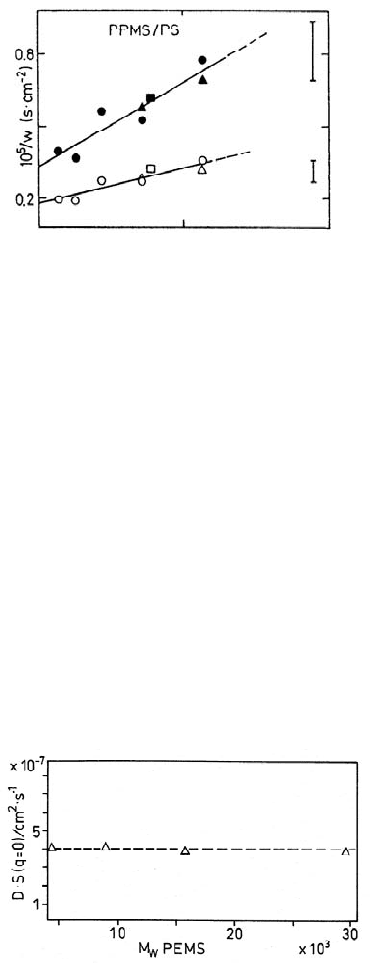
16 Diffusion in Colloidal and Polymeric Systems 705
0
0.5
1
φ
PS
o
Fig. 16.30. Variation of the inverse of the kinetic factor W
0
= DS/(φ(1 − φ))
versus volume fraction of PS, for blends of PS and PPMS (M = 2600), with PS
molecular weights M of 9000 (circles), 4000 (squares), and 2000 (triangles). Filled
symbols refer to T = 280 K and open symbols to T = 330 K. There is a linear
φ-dependence as predicted by the RPA slow-mode form. Data taken from [111].
’solid-like’ component, which reflects its stronger proximity to the glass tran-
sition point of pure PS. The blend demixes for larger values of φ
PS
. Therefore,
values for W
0
are shown in Fig. 16.30 for the one-phase region only.
According to its definition in (16.271), and according to the fast-mode,
slow-mode and ANK results for the Λ
l
in
of unentangled chains, which depend
all on the segmental diffusion coefficients D
0α
only, W
0
should be a local dy-
namic quantity, independent of the polymerization degree or, likewise, mole-
cular weight of the polymers. The predicted molecular-weight-independence
of W
0
= DS/(φ(1 − φ)) has been confirmed [112] from static and dynamic
light scattering experiments on blends of poly(ethylmethylsiloxane) (PEMS)
and poly(dimethylsiloxane) (PDMS) polymers, where the molecular weight
of PEMS has been varied (cf. Fig. 16.31).
Fig. 16.31. Measured kinetic factor Λ = DS(q → 0)forablendofPDMS(p = 100)
and PEMS polymers at PEMS volume fraction φ
PEMS
=0.67 and T =20
◦
C versus
molecular weight, M
W
, of PEMS. The M
W
-independence of Λ for Rouse chains is
clearly seen. Data from [112].

706 Gerhard N¨agele, Jan K. G. Dhont, and Gerhard Meier
While the diffusion in certain binary blends, like PS/PPMS, is well de-
scribed by the RPA slow-mode result of incompressible systems, there is a
larger class of blends which conform to the fast-mode form of interdiffusion.
One well-characterized example is a nearly symmetric polysiloxane mixture of
low-molecular weight PDMS (p=80) and PEMS (p=90) polymers. Due to a
very distant glass-transition point, this system appears more as a ’liquid-like’
and compressible system. Experimentally determined values for D and S in
this blend as function of φ
PEMS
are listed in Fig. 16.32a, together with val-
ues for the kinetic factor determined from the operational equation (16.271).
The linear volume fraction dependence of W
0
is in accord with the fast-mode
result in (16.265). We note further that the measured S is well described by
(16.270).
There is an interesting relationship between the fast-mode behavior of
W
0
in PDMS/PEMS blends and their shear-mechanical properties. From
mechanical measurements of the low-shear-rate limiting viscosity, η
AB
,inthe
blend, one can calculate a mean friction coefficient, γ
AB
, assuming Rouse
dynamics in a mixture [13],
γ
AB
=
36η
AB
M
2
0
ρa
2
N
A
M
, (16.272)
where M
0
= φ
A
M
A
+ φ
B
M
B
and ρ = φ
A
ρ
A
+ φ
B
ρ
B
, respectively, are the
mean monomeric molecular weight and the mean mass density of the blend;
N
A
is the Avogadro number, and M the mean polymeric molecular weight
in the blend. Since mass transport by interdiffusion is related to the viscosity
in the medium, it appears likely that a generalized Stokes-Einstein relation
W
0
∝ k
B
T/γ
AB
holds, provided that vitrification effects due to the proximity
to a glass point do not play a role. A plot of 1/γ
AB
versus φ should then
result in a linear composition dependence. Fig. (16.32b) proves that this is
the case indeed. From the fast-mode-like form of 1/γ
AB
one concludes that
the inverse of the mean friction coefficient can be expressed solely in terms
of the A and B monomer friction coefficients, γ
α
in the blend, according to
γ
−1
AB
= φ
A
γ
−1
A
+ φ
B
γ
−1
B
.
The approximate fast-mode and slow-mode expressions for Λ
l
in
do ap-
ply only to selected polymer mixtures, with varying degree of accuracy
in each case. The fast-mode or vacancy model appears to be more con-
sistent with lower molecular weight blends, whereas the slow-mode or in-
compressible model is more consistent in the high molecular weight regime.
For an example of this trend, consider Figs. 16.33 and 16.34 which dis-
play time-resolved static light scattering data of Feng et. al [114] for the
kinetic interdiffusion factor (called mobility M in the notation of [114]) of a
poly(styrene)/poly(vinylmethylether) blend (PS/PVME) for varying molec-
ular weight N
PS
of PS. In the experiments by Feng et al., the interdiffusion
coefficient has been determined from temperature quench experiments within
the miscible one-phase region. The measured decay of density (composition)
fluctuations right after the quench has been interpreted in these experiments
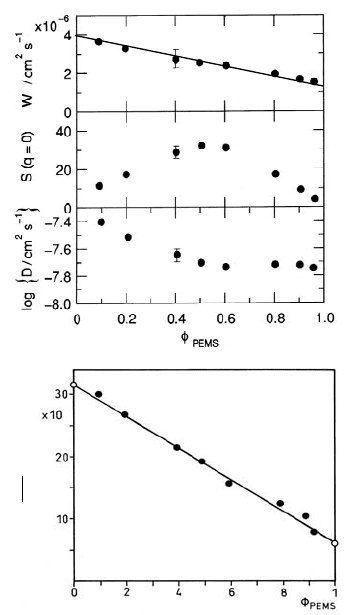
16 Diffusion in Colloidal and Polymeric Systems 707
(a)
o
(b)
13
s/kg
1
1-
AB
Fig. 16.32. (a) Apparent diffusion coefficient D, measured static structure factor
S(q → 0), and kinetic factor W
0
for a nearly symmetric blend of PDMS (p=80)
and PEMS (p=90) versus composition φ
PEMS
at T =20
◦
C. The straight solid line
is the fast-mode prediction for W
0
. Data from [113].
(b) Inverse of the friction coefficient, γ
AB
, for the same PDMS/PEMS mixtures as in
(a), deduced from rheological measurements of the blend viscosity, η
AB
, as explained
in the text. The linear composition dependence of 1/γ
AB
verifies a generalized
Stokes-Einstein relation W
0
∝ k
B
T/γ
AB
for interdiffusion. Open circles at φ
PEMS
=
0, 1 refer to the pure components. Data from [112].
in terms of the celebrated Cahn-Hilliard-Cook (CHC) expression for the time-
resolved average scattered intensity of binary blends (cf. [29,114]). We remark
that the CHC expression is commonly used also to interpret the early stages
of spinodal composition of binary mixtures right after a sudden quench into
the mechanically unstable two-phase region.
The chains in the PS/PVME blend are in a bulk-entangled state, so that
the self-diffusion coefficient of a chain scales, different from Rouse chains, with
the inverse square of the molecular weight. In the entanglement case, W
0
is
not any more a local property independent of molecular weights. Substitution
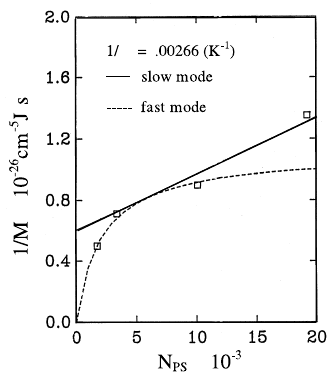
708 Gerhard N¨agele, Jan K. G. Dhont, and Gerhard Meier
T
Fig. 16.33. Inverse mobility data, M
−1
∝ 1/Λ
l
in
, versus molecular weight, N
PS
,of
PS in PS/PVME blends. The dashed line (solid line) is a fit of the fast-mode (slow-
mode) model to the experimental data. Both models show systematic deviations
from the data. After [114].
of D
p
0α
= D
0α
/p
2
α
into (16.258), (16.265) and (16.264) leads for the inverse
mobility 1/M ∝ 1/(x
A
x
B
Λ
l
in
), according to the slow-mode expression, to
linear dependence on the degree of polymerization p
α
. On the other hand,
the fast-mode model predicts a concave curve for 1/M plotted versus p
α
,
with an infinite slope at p
α
= 0 and a horizontal asymptote for large p
α
[29].
Fig. 16.33 includes experimental data of 1/M for four different molecular
weights, N
PS
, of PS. Neither the fast-mode nor the slow-mode expression
can adequately fit the data. The fast-mode model applies only to the low-
molecular-weight side, and the slow-mode model only for large values of N
PS
(cf. Fig. 16.33).
Inverse mobility data of PS/PVME versus N
PS
for two different tem-
peratures are depicted in Fig. 16.34, in comparison with the predictions of
the ANK formula. As one can see, the molecular weight dependence of the
kinetic factor in PS/PVME is well described by the ANK model, with the
(third) matrix component interpreted as ’vacancies’. The solid curves in Fig.
16.34 were plotted using the matrix parameter x
C
D
C0
/p
C
occurring in the
entanglement version of the ANK formula as a fitting parameter. However,
this matrix parameter can be related to the cooperative diffusion coefficient
in a binary mixture, which is a measurable quantity [29]. This deliberates us
from needing to assign a meaning to the diffusion coefficient of a vacancy.
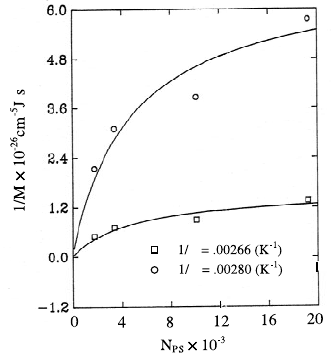
16 Diffusion in Colloidal and Polymeric Systems 709
T
T
Fig. 16.34. Inverse mobility data, M
−1
,versusN
PS
, in PS/PVME blends at two
different temperatures as indicated. The solid lines are fits of the ANK formula
(16.264) to the data, demonstrating the applicability of the ANK-theory over the
whole range of PS molecular weights. After [114].
16.6 Conclusion
The aim of this chapter was to analyze the physics of various diffusion
processes observed in colloidal fluids of spherical and rod-shaped particles,
and in binary polymer melts, to describe dynamic light scattering techniques
and other optical methods (FRAP and FCS) used for probing diffusion, and
to explain theoretical methods and computer simulation techniques which al-
low one to calculate diffusional transport properties and scattering functions.
Dynamic light scattering as described in Sect. 16.2 is nowadays a standard
technique to measure diffusion properties of colloids and polymers. The new
developments in this area are in the direction of scattering geometries, where
the dynamics under the influence of external fields (like pressure, shear flow,
electric field and temperature gradients), near walls and within interfaces
can be probed. In addition, somewhat slower dynamical processes are being
studied nowadays by means of optical microscopy, such as confocal laser
scanning microscopy (CSLM). Scattering from single colloidal particles can
be used to probe local properties in the possibly inhomogeneous system under
consideration.
Besides translational dynamics, FRAP can also be used to measure the ro-
tational dynamics, where the polarization dependence of excitation and emis-
sion probabilities are exploited. Time-resolved phosphorescence anisotropy
(TPA) has recently been used to measure rotational diffusion of colloids as
well [115, 116]. FRAP has been applied some time ago to probe long-time
diffusion under oscillatory shear flow. A similar method is forced rayleigh
